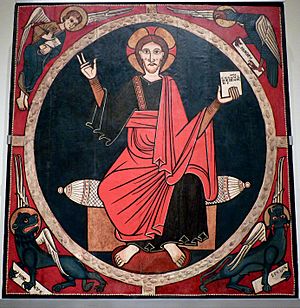Baldachin from Tost facts for kids
Quick facts for kids Baldachin from Tost |
|
|---|---|
 |
|
| Artist | Anonymous |
| Year | c. 1220 |
| Type | Tempera, stucco reliefs and remains of varnished metal plate on wood |
| Dimensions | 176.5 cm × 161 cm (69.5 in × 63 in) |
| Location | Museu Nacional d'Art de Catalunya, Barcelona |
The Baldachin from Tost is a special painted canopy. It used to hang over an altar in a church. Today, you can see it at the National Art Museum of Catalonia in Barcelona. This artwork was made around the year 1220.
What is a Baldachin?
A baldachin is like a fancy roof or canopy. In churches, it was placed over the altar. This made the altar look more important and sacred. The Baldachin from Tost was attached to the wall behind the altar.
Other types of baldachins looked like small shrines. Some were made of wood, like one from Toses. Others were made of stone, like parts found from a monastery in Ripoll.
What Does the Baldachin Show?
The main part of the Tost baldachin shows a picture of Jesus. He is shown as the "Lord in Majesty." He has a special halo with a cross in it. Jesus is sitting on a throne inside a bright, almond-shaped frame called a mandorla. This mandorla was probably golden once.
In his left hand, Jesus holds a book. On the book, it says EGO SVM LUX MVNDI. This is Latin for "I am the light of the world." With his right hand, he makes a sign of blessing.
Around Jesus, there are four symbols. These represent the four writers of the Gospels, called the Evangelists. They are often called the Tetramorph.
- A human or angel for Matthew
- A lion for Mark
- A bull for Luke
- An eagle for John
Instead of holding books, each symbol has a scroll with its name. You can see how the eagle (for John) and the bull (for Luke) fit into the space. The artists sometimes changed the shapes to make them fit.
The Art Style and Colors
This artwork shows a mix of old and new art styles. For example, Matthew's angel looks more natural and lifelike. This style was becoming popular with the new Gothic art movement. It shows how art was changing a lot during that time.
Recent cleaning and repair work helped bring back the original colors. Now, the bright blue and red colors look very vibrant again.
See also
 In Spanish: Baldaquino de Tost para niños
In Spanish: Baldaquino de Tost para niños

